KAYAKING ESSENTIALS
Whether you're a seasoned kayaker or a beginner, our guide is here to help. Take your kayaking to the next level with our list of kayaking essentials.
Thinking about getting out into the water? Great, you’ve come to the right place. We’ve put together all the essentials you need for a successful kayaking experience. Whether you’re planning on paddling in calm summer waters for a bit of fishing or challenging yourself to white water winter kayaking, we've got you covered. Here’s everything you should know before going kayaking. If you’re a complete beginner in the kayaking world, then take a look at our Kayaking for beginners guide to get you started.
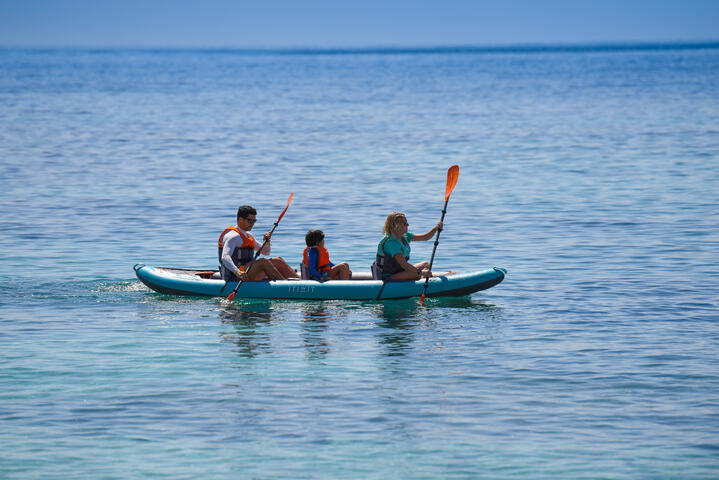
What are Kayaking Essentials?
Essentials are the bare minimum must-haves you need to ensure you have a safe and enjoyable kayaking experience. To make this list, we’ve taken into consideration safety, practicality and skill level. Take a look at our list of essential kayaking gear to help you start your paddling journey
The Right Kind Of Kayak
This probably goes without saying, but you’ll need a kayak that’s suitable for the kind of waters and activities you’re planning. Different types of kayaks are made to suit different skill levels and activities, so it’s important to familiarize yourself with what they are. We’ve put together an extensive guide on how to choose your kayak to help you find your perfect fit. You may have come across the terms sit-on and sit-in kayaks and wondered what they mean and what’s the difference.
It’s all in the name; a sit-on kayak is when you sit on top of the kayak, while a sit-in kayak is when you sit inside the open cockpit of the kayak. Usually, your lower body, starting from your hips and below, is positioned inside the kayak hull, with your legs under the deck. A sit-on-top kayak is often recommended for beginners, as it’s easier to climb back into should you find yourself capsized in the water. In contrast, sit-inside-kayaks are a more advanced choice for those venturing into rough waters that would benefit from a lower center of gravity for better stability whilst paddling, leaning and turning.
A Paddle Or Two
Another important kayaking essential is a kayaking paddle; they should be at the top of your list when planning your kayaking trip; you won't be able to move or maneuver your kayak without one. Although paddles may seem like they’re all the same, kayak paddles are different from canoes or stand-up paddle boards because they have blades at both ends.
You should consider your height when picking out your paddle. The general guideline is; that the taller you are, the longer your paddle should be, but your decision should ultimately be based on whatever feels most comfortable to you. It’s also a good idea to take a spare paddle with you, just in case you break or lose one.
Buoyancy Aid Or Buoyancy Vest
Buoyancy aids are very similar to life jackets but allow more freedom of movement for your arms and neck, making them ideal for paddling. Buoyancy aids are highly recommended for everyone participating in water sports; whether you consider yourself a pro at kayaking or a super strong swimmer, you should still wear a buoyancy vest to protect you from the unpredictable nature of being out in the water.
Protective water Sports Helmet
Kayaking helmets tend to be worn by both beginners and advanced paddlers alike; they not only protect your head from injuries caused by your surroundings but are also useful for protecting you when you accidentally hit yourself with your own paddle (yes- it happens!) not only that, you may also need protection from the person you’re kayaking with, who may be paddling with you in the same kayak or in another vessel nearby.
Wetsuit Or Dry Suit
What you choose to wear when kayaking can depend on the weather. If it’s a really warm day, you could get away with wearing your regular shorts and a t-shirt, but don’t let the warm weather fool you; even if the air feels warm, the water might still be very cold. In any case, you should be prepared to get wet, whether it’s completely capsizing or getting splashed on from paddling. That’s why a dry top or kayaking cagoule tends to be our go-to kayaking wardrobe essentials.
A wetsuit is a great option if you want extra protection, especially on a cold day. But if you’re after something completely watertight, you might want to invest in a dry suit. Dry suits tend to be on the pricier end when it comes to kayaking clothes, but they are a very worthy investment nonetheless. Their waterproof capabilities allow you to wear your normal clothes underneath without getting wet; this also means you can choose what level of warmth you need from your dry suit by dressing appropriately underneath, making it a great choice for extremely cold environments.
If you’re still unsure about what to wear or want more information on essential kayaking gear, then check out our detailed guide on What to wear kayaking to ensure you’re properly kitted out and ready for all your kayaking adventures ahead.
A Pair Of Wet Shoes
If you want your feet to stay dry and steady on slippery surfaces while enjoying water sports, then you need a pair of wet shoes. They’re usually made out of neoprene fabric, fitted with a rubber sole for extra grip. Wet shoes will allow you to confidently walk into the lake, river or sea, knowing your feet are protected from stepping on anything painful in the water.
You should avoid wearing flip-flops as they don’t provide any protection or grip. The same goes for trainers,although a better choice compared to flip-flops, trainers won’t be able to provide you with the water-proof protection you need to stay comfortable and dry in your kayak, and we can all agree that no one likes soggy socks or water-clogged trainers.
A Dry Bag
Dry bags come in very handy when you’re out on the water; they’re specially made to be watertight so you can keep all your valuables dry. The perfect piece of kit to store your mobile phone, spare set of clothes, snacks and anything else you don’t want to get wet. A dry bag may not always be necessary, but if you’re planning on spending a long time out in the water, it’s best to pack emergency supplies such as a torch, compass, map, GPS, towel, water and food. If you’re a beginner or generally prone to capsizing, then you’ll want to look for dry bags with shoulder straps; that way, you can feel secure in knowing your belongings are with you no matter what.
A Spray Deck Or Spray Skirt
Not necessarily an essential piece of kit for beginners but a useful addition nonetheless. Particularly useful if you’re an advanced paddler who likes to venture out to sea or take on rapid waters, spray decks are waterproof skirts that cover your lower body when you sit inside the cockpit of your kayak. The spray deck’s primary function is to help stop water from getting into your kayak. Kayak spray decks come in a variety of materials which function best in different environments. Nylon spray decks are generally used for sea kayaking as they’re more spacious and have better air ventilation— great for longer journeys. Neoprene spray decks are the top pick for whitewater kayaking as they keep water out when rolling and are durable enough to withstand the force of choppy waters and breaking waves.
Throw Rope Or Rope Bag
Throw ropes are designed to float, they’re essential kayaking gear that could potentially be life-saving. Throw ropes usually come in rope bags, making them easy to carry should you need to rescue a fellow kayaker. You use it by holding on to one end of the rope and throwing the other out to the person in danger. It’s not usually a piece of equipment that a beginner would be expected to have, as your instructor will most likely be equipped with one, but if you’re out on your own or without a group, then a throw rope is a must.
A Kayak Trolley
A kayak trolley is extremely helpful, especially if you have a long way to walk to the water. Kayak trolley will make transporting your kayak into the water so much easier; the thought of dragging your kayak against a pebbly beach is both jarring and damaging to the underside of your kayak, so grab yourself a handy trolley to help you set off into the water with ease.
What Accessories do I need for Kayaking that I may not know about?
The list above is great for helping you start your kayaking journey but only scratches the surface of what you’ll need as you progress.
Once you’ve gotten comfortable with paddling and navigating the waters, consider taking things to the next level and check out our huge range of kayaking accessories to help you find all the kayaking equipment you need to help you along the way.
HOW TO KAYAK
Kayaking is great fun and a great workout for all ages and abilities. If you're keen as mustard to give it a whirl, this one's for you!
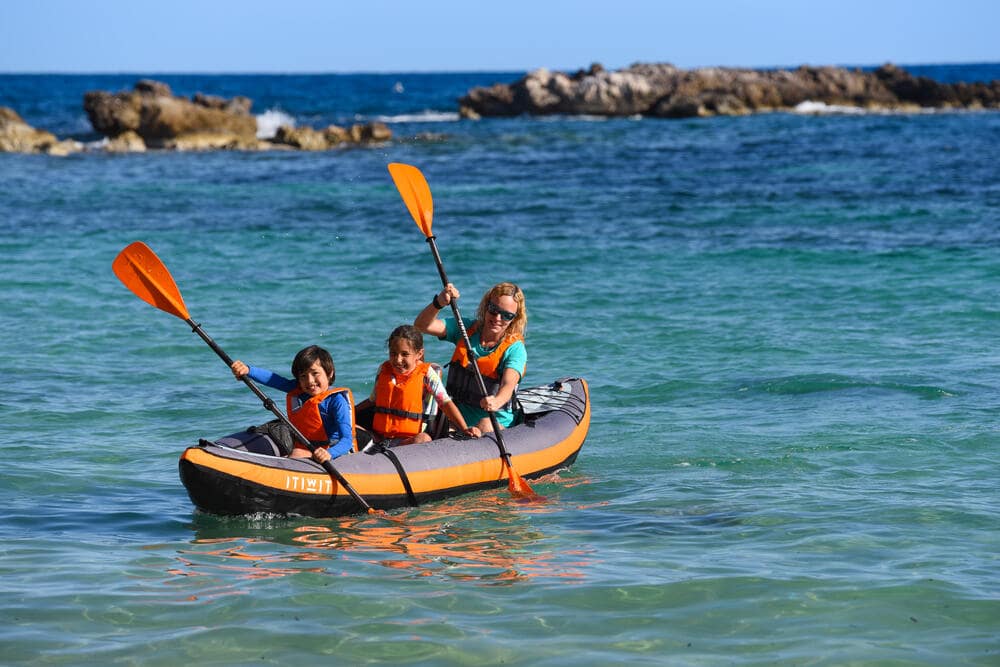
Adjustments
Adjusting your position in the kayak is one of the first things you will want to do before kayaking. After all, a well-adjusted kayak will be far more stable and comfortable to paddle in.
Now we aren’t going to lie to you here...everybody looks like a bit of a drongo on their first time mounting one of these bad boys, especially if you are already on the water. So, we highly recommend making all your necessary adjustments while sitting on dry land.
Scooch your buttocks against the seatback – You will want to find a comfortable position so that you are able to sit upright.
Adjust your footrest so that the balls of your feet are on the footpegs, then see if you can bend your knees – If you are planning on sharing your kayak with others, you will also want them to adjust their footrest. If, however, playing footsies with your mate isn’t your cup of tea, then you can always go solo and grab yourselves one of our ITIWIT Inflatable 1-Person Kayaks. Note: not all kayaks require footing adjustments.
Bent knees are firmly touching either side of your cockpit – Snug enough so you feel in control of your craft, but not so snug that you are unable to get out. Remember, we want to enjoy ourselves here!
Launching
Launching your kayak can be a relatively easy affair so long as you take care. Ideally launch from a gradually sloping shoreline. Avoid dragging the hull, place paddle under the deck line in front of the cockpit while the shaft is facing sideways, stand over the kayak and commence straddling the cockpit.
Grab cockpit firmly and begin to set your buttocks on the seat, then like an elegant swan simply lift your legs and slide your feet into the cockpit
Once seated, grab your paddle, and use it to leverage your kayak past those incoming waves. For easy dismount, simply paddle up into your launch position and follow the above steps in reverse. And Bob’s your uncle, you have now learnt to kayak!
You are welcome.
Remember safety is paramount. Always remember to wear your lifejacket.
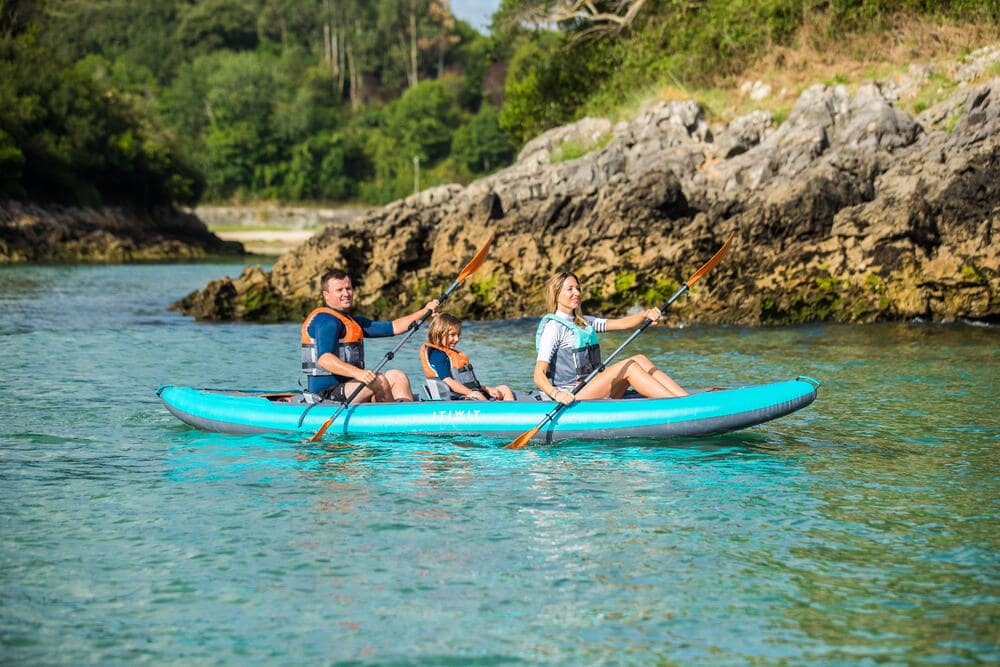
What to Wear When Kayaking
Remember the old Kindy game of Head, Shoulders, Knees and Toes? Well that is exactly how we are going to start this one off!
Head
We can never stress enough the importance of a good hat. Especially with the Australian sun beating down on you. For mild conditions when kayaking it's best to look for hats with wide brims or capes. For example, our OLAIAN Men’s Surf Hat, with its UPF rating of 50+ will do the trick just fine. Don't forget to slip, slop, and slap some sunscreen on the back of your neck.
Shoulders
Another fairly essential sun smart item would of course, be the humble rashie. Ideally you will be looking for one that offers protection against harmful UV rays, is quick drying and stretches well. Take our OLAIAN 500 Women’s Long-sleeve Surfing T-Shirt for example. Something you may wish to avoid, however, is cotton, given its ability to absorb and hold onto water.
Knees
No one likes the look of lobster legs and this can be easily avoided by kitting yourself up with board shorts. Just be sure to avoid pants that bind of chafe, after all, you do want to be comfortable!
Toes
Protection for your feet is just as important, and proper kayaking shoes just makes the experience all the more enjoyable. Which is why we recommend our abrasion resistant and thermal comfort ITIWIT 100 Kayak/Stand-Up-Paddle Neoprene Shoes. Perfect for those cooler mornings out in the big blue.
Do Not Forget
Always pack your sunscreen and slip, slop, slap
Always wear a life jacket because life jackets save lives
Bring plenty of water
The Take Away
A little bit of common sense goes a long way when working out what to wear in the wet. So, make sure you dress yourself for the conditions and activity at hand. Always make sure to bring plenty of water and sunscreen.
What is the Best Inflatable Kayak to Buy?
Need help choosing an inflatable kayak? Let us take you through everything you need to know about inflatable kayaks so you can spend your time paddling around!
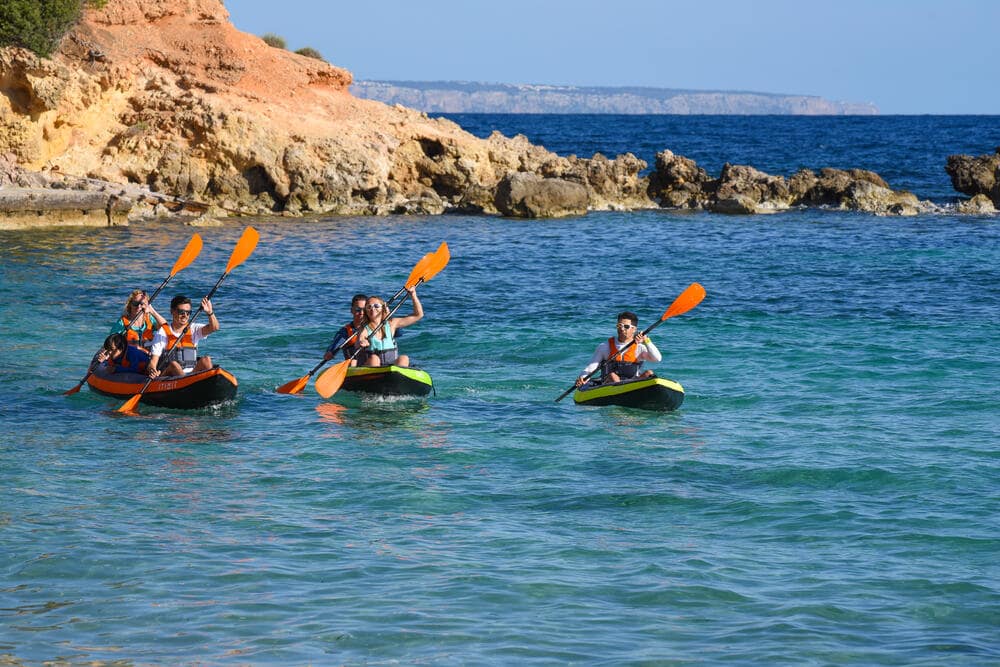
Are They Durable?
They sure are! Unlike our old friend the pool croc who after experiencing a few turns would slowly deflate into a green mass of flimsy plastic – inflatable kayaks are not made with the same thin layer of flimsy plastic. Our inflatable kayaks are composed of multiple layers of thick Polyesters and Polyvinyl Chloride – which means that these crafts are designed to take a beating. That is not to say you should go ahead and start dragging it over every bit of gravel you find, but under normal circumstances our inflatable kayaks will be able to last. With a little common sense, your kayak should survive without any issue. But, if you do happen to puncture one, it’s okay because most inflatable kayaks are easily repaired with a small patch kit, and to reinflate just grab one of our ITIWIT Double Action Kayak Hand Pumps. The advantage of an inflatable kayak is that, when deflated, it fits in a backpack and therefore can be transported in a car boot.
How many users?
You can go kayaking alone or with others; make it a solo trip or a family affair! We sell models for 1 person to 3 people; for beginners to intermediates.
What do you want to use it for?
Occasional Trips. If you go on occasional or short trips (from 1hr-1/2 day and at most 300m from land) in calm weather, you’ll want comfort and stability, so choose a wide and flat kayak model like our Beginner 100 Range.
Regular Trips.
If you go on long trips (from 1/2 day-1 day and from 300m to 2 nautical miles from land), you need good glide quality. Choose a tapered kayak model like our beginner X100 2/3 places drop-stitch floor inflatable touring kayak-turquoise.
So, which one is the best for me?
That all depends on you and your intentions. If for example, cruising with your mates or family is something you’d like to do, then you simply cannot go past our ITIWIT 2-3 Person Inflatable Cruising Kayak. Designed for user comfort and ease of use, this inflatable kayak is stable and reassuring and inflates in 10 minutes with our Double Action Hand Pump. If however you are the solo type, then you may wish to consider grabbing yourself an ITIWIT 1 Person Inflatable Cruising Kayak. Just remember to always wear a life jacket. You can shop our range of Life Jackets here.
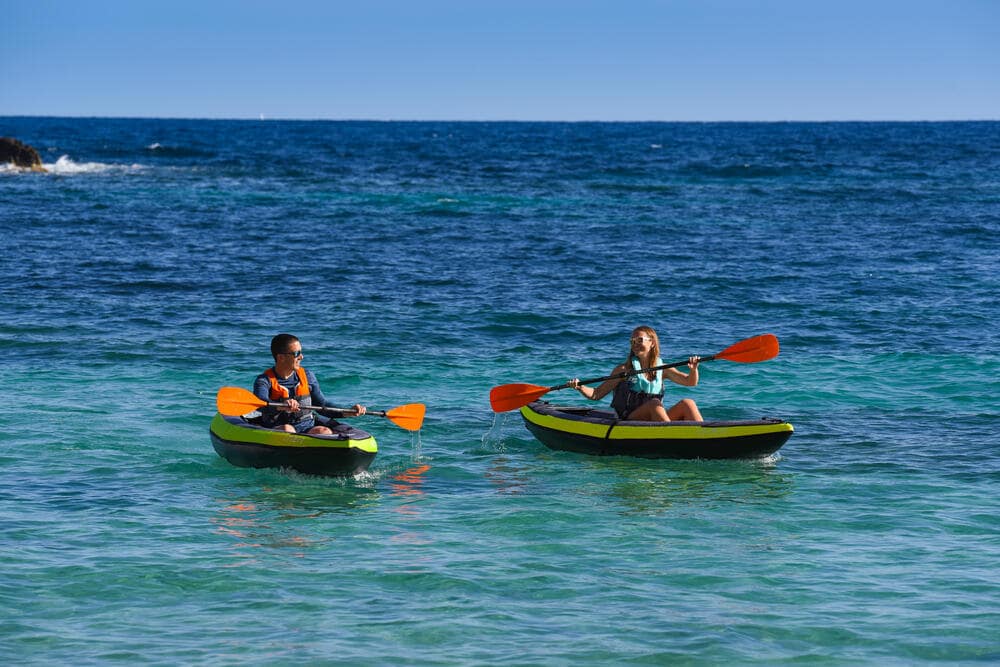
Is Kayaking a Good Workout?
If you’re looking for a way to keep fit and healthy but high-impact, intense exercise isn’t your thing - we’ve got great news for you.
Kayaking is a low impact activity with numerous health benefits attached, as well as the added pleasure of being out on Australia’s beautiful waters.
Benefits
- Improves aerobic fitness, strength, and flexibility
- Improves cardiovascular fitness
- Improves muscle strength in your back, arm, shoulders, and chest
- Increases torso and leg strength
- Reduces risk of wear and tear on joints and tissues
It’s for everyone
Even if you do not consider yourself to be a particularly fit individual, paddling is great for most anybody from kids to oldies, of any fitness level. Whether you consider yourself to be a bit of a speed demon or just looking for that low-impact routine, you will find the right kayak can accommodate just about anyone, even your dog. For the movers and shakers out there, you simply cannot go past our Inflatable 1-Person Kayak. This bad boy is built for speed.
But wait, there’s more!
Aside from the physical benefits of kayaking, getting out on the water and surrounding yourself with all that stunning Australian scenery is also great for the soul and a way to de-stress and meet new mates. In fact, experts believe that being exposed to nature evokes positive emotions and strengthens individual resilience. It also has positive impacts on your concentration, learning, critical thinking capacity, problem-solving skills and creativity.
Before Hitting the Water
To make the most of your exercise, always remember these fitness and health tips
Stay well hydrated - Before, during and after your exercise
Stretch before and after – Just like any other exercise, it is important to give yourself a good stretch out before and after to help prepare and relax your muscles
Sunscreen – Slip, Slop, Slap! You want to spend time with the lobsters, not come back looking like one
Always wear a Life Jacket – Life jackets save lives
The Take Away
Kayaking is a wonderful activity and has many positive health benefits such as an overall improved cardiovascular fitness, increased muscle strength and reduced risk of wear-and-tear on joints given that it is a low impact activity. But with any activity that involves being on the water, we always recommend you go with a friend.
So, what are you waiting for? Best run down to your local Decathlon store and pick yourself up a kayak and start heading out into the vast beyond.













